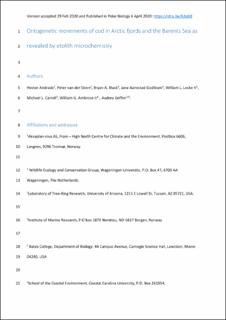| dc.contributor.author | Andrade Rodriguez, Hector Antonio | |
| dc.contributor.author | van der Sleen, Peter | |
| dc.contributor.author | Black, Bryan A. | |
| dc.contributor.author | Godiksen, Jane Aanestad | |
| dc.contributor.author | Locke V, William L. | |
| dc.contributor.author | Carroll, Michael Leslie | |
| dc.contributor.author | Ambrose, William G. Jr. | |
| dc.contributor.author | Geffen, Audrey J. | |
| dc.date.accessioned | 2021-06-08T12:18:13Z | |
| dc.date.available | 2021-06-08T12:18:13Z | |
| dc.date.created | 2020-06-11T15:08:16Z | |
| dc.date.issued | 2020-04-06 | |
| dc.Published | Polar Biology. 2020, 43 (5), 409-421. | |
| dc.identifier.issn | 0722-4060 | |
| dc.identifier.uri | https://hdl.handle.net/11250/2758515 | |
| dc.description.abstract | The distribution of Atlantic cod (Gadus morhua) in northern Norwegian waters is expanding eastward and northward in the Barents Sea and along western Svalbard. In the Arctic fjords of Svalbard, cod has become abundant, but little is known about the biology, origin, or residence patterns of these populations. To address this issue, we used laser ablation inductively coupled plasma mass spectrometry to quantify the trace elemental composition of cod otoliths at age-0, age-3 and the year of spawning at five distinct locations in northern Norway and western Svalbard. Chemical composition data was used to identify natal sources of cod, their broad-scale migration patterns, and to determine if cod are currently resident in Arctic fjords. Our results suggest that cod collected at Kongsfjord, Isfjord, outside Svalbard, Lofoten, and Porsangerfjord were recruited mainly from the Barents Sea, conforming to the Northeast Arctic cod ecotype. The degree of chemical overlap between Porsangerfjord and Isfjord cod, however, varied with fish age, suggesting individual movements consistent with the Norwegian coastal cod ecotype. Finally, the chemical composition of mature fish at Isfjord, and to a lesser extent Kongsfjord, suggests that cod from the Barents Sea might have recently established residency in these two Arctic fjords. | en_US |
| dc.language.iso | eng | en_US |
| dc.publisher | Springer | en_US |
| dc.title | Ontogenetic movements of cod in Arctic fjords and the Barents Sea as revealed by otolith microchemistry | en_US |
| dc.type | Journal article | en_US |
| dc.type | Peer reviewed | en_US |
| dc.description.version | acceptedVersion | en_US |
| dc.rights.holder | Copyright Springer-Verlag GmbH Germany, part of Springer Nature 2020 | en_US |
| cristin.ispublished | true | |
| cristin.fulltext | postprint | |
| cristin.qualitycode | 1 | |
| dc.identifier.doi | 10.1007/s00300-020-02642-1 | |
| dc.identifier.cristin | 1815094 | |
| dc.source.journal | Polar Biology | en_US |
| dc.source.40 | 43 | |
| dc.source.14 | 5 | |
| dc.source.pagenumber | 409-421 | en_US |
| dc.relation.project | Norges forskningsråd: 228107 | en_US |
| dc.identifier.citation | Polar Biology. 2020, 43, 409-421 | en_US |
| dc.source.volume | 43 | en_US |
